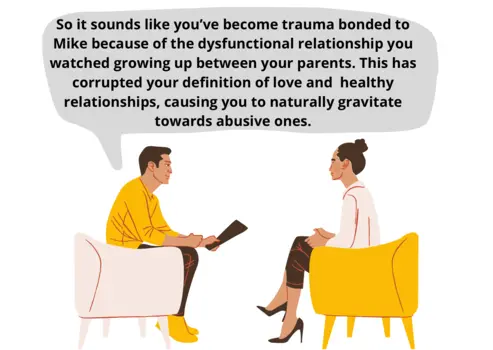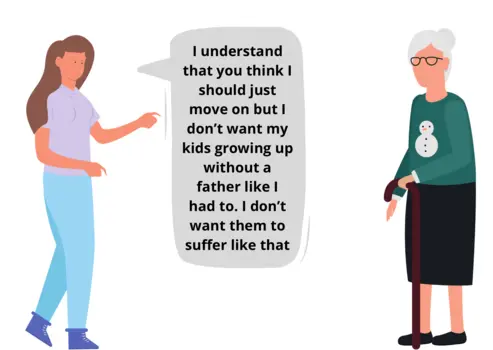One of the most common mistakes people make when learning about trauma bonding is equating it with Stockholm syndrome. While the two bonds are extraordinarily similar, it is important to differentiate the two because when dealing with a trauma bonded relationship, having the correct information is often the difference between escaping the abuse cycle and remaining trapped within it for the foreseeable future.
Trauma bonding and Stockholm syndrome are not the same because Stockholm syndrome is a coping mechanism that is only seen within victims of abuse who believe that their lives are in danger and trauma bonding is an emotional attachment formed by a cycle of abuse and manipulation that isn’t always life threatening.
Simply put, for the coping mechanism known as Stockholm syndrome to be present within a victim of abuse, the victim has to believe that their life is in danger. However, there are a numerous number of reasons that a victim of abuse would develop a trauma bond for their abuser that are very rarely life threatening.

Where Did the Term “Stockholm Syndrome” Come From?
The term “Stockholm syndrome” originates from a bank robbery in Stockholm Sweden in the summer of 1973 when a group of bank robbers held four people hostage for six days. During the hostage negotiations the bank robbers made it very clear that they were capable of violence by shooting police officers and threatening the lives of the hostages on numerous occasions.
But interestingly enough, a hostage named Kristin Enmark, was very vocal about her sense of safety with the hostages but crippling fear of the police. When the authorities were finally able to rescue the hostages, the hostages actually tried to protect and defend the bank robbers.
The Similarities Between Stockholm Syndrome and Trauma Bonding
The loyalty that the hostages had for their captors is remarkably similar to the loyalty victims of trauma bonded relationships have for their abusers in the sense that they made a conscious decision to justify, rationalize, and ultimately normalize the life threatening situation their captors placed them in which happens to be a huge indicator of a trauma bond.
Suggested Reading: What Are the Signs of a Trauma Bonded Relationship?
Something else that makes Stockholm syndrome similar to trauma bonding is that for Stockholm syndrome to be present, a person must be held in captivity and become dependent on their captor for their lives. A person must be completely isolated with only the captor’s perspective throughout the entirety of the crisis.
The captor must threaten to kill the hostage and the hostage must see the perpetrator as showing some degree of “kindness”, even if that kindness is misinterpreted.
All victims of trauma bonded relationships are dependent on their abuser, not necessarily for their lives, but to conceptualize an “accurate” version of reality. It is also extremely common for victims of trauma bonded relationships to be isolated from friends and family.
Last, but certainly not least, victims of a trauma bonded relationship are often manipulated into equating abuse with genuine love, compassion, and empathy.

An Example of Stockholm Syndrome
A very well known example of Stockholm syndrome in the United States is the story of Patty Hearst. In 1974 she was kidnapped by the Symbionese Liberation Army, a violent left wing group back in the 70’s in California.
Being from one of the wealthiest families in the United States at the time, her absence for 19 months was a very big deal. But the most surprising aspect of her abduction was the fact that she had participated in bank robberies and attempted bombings the entire time she was missing.
So, by the time police caught up with her, it wasn’t to rescue her, it was to arrest her. She ended up being sentenced to 35 years in prison but later pardoned by President Bill Clinton.
The reason she was pardoned is because that it was later revealed that she experienced sexual violence and threats on her life while in captivity. When she was captured, she was blindfolded with her hands behind her back and placed in a closet for a week.
She was forced to memorize the SLA political tracts. Her captors would float the idea of killing her if she didn’t join them. Then after enough time had passed, she was given the opportunity to leave or join the SLA. Out of fear of her own life, she chose to join.
So, Patty was held in captivity, her life was repeatedly threatened, she was isolated, only had her captor’s perspective because she was forced to memorize their handbook, and was shown “kindness” when given the option to leave. Her story fits the criteria of Stockholm syndrome.
An Example of Trauma Bonding
When Amy was six years old, her father left the family, leaving the mother to raise Amy on her own. When Amy turned twenty, she was determined to reconnect with her father so she reached out to him via email and set up a time to grab a coffee.
Much to her surprise, her father told her that he didn’t consider her to be his daughter because he already had a daughter and two sons with his new wife. The devastation from the rejection shook Amy to the core and not long after she met a man named Ben who was an alcoholic, impulsive, and abusive.

Amy and Ben got married within the first six months, which is very common to see in relationships with a lot of fatuous love, and had a daughter and son within the first few years of their marriage.
When Amy’s and Ben’s youngest child was born, Ben started having multiple affairs, drinking a lot more, and quitting job after job to start “groundbreaking” businesses with his brothers.
Amy justified, rationalized, and ultimately normalized Ben’s drinking problem and “ambition” but she didn’t know that Ben was having multiple affairs. To support the family Amy asked friends and family to look after her kids so she could work a full-time and part-time job and allow Ben to pursue his dreams.
Over the next few months Ben manipulated Amy into giving him thousands of dollars to keep the business alive even though she has never seen or heard much detail about it. But she blindly trusted Ben because he told her that he wants to show it to her when he is proud of it.
A few more months go by and Amy gets fired from her job which means that she can’t give Ben anymore money. In a terrifying narcissistic rage, Ben explodes and reveals to Amy that the business is going bankrupt and it is all her fault.
Amy feels horrible about the whole situation and spends a week searching for a job so she can save Ben’s business. When she finally finds one, Ben tells her that it is too late and reveals to her that he is going to move in with one of the women he was having an affair with because she can better support her needs.
Devastated, Amy spent the next few months begging Ben to come back home and he did because Amy promised to give him 25 thousand dollars for his business. The reason she was so determined to get him back into the home is because she didn’t want her children to grow up without a father because that was so traumatizing for her.

This dysfunctional cycle continued for many years. Ben was constantly maxing out credit cards, having affairs, and blaming Amy for everything that was wrong in his life, until one day, Ben filed for divorce, moved in with one of the women he was having an affair with, and never came back.
Amy started seeing a therapist because she wanted to learn how to change so Ben would come back. She wanted to learn how to be a better wife, how to meet his needs, and how to tolerate his infidelity. In the end, Amy left therapy because she was afraid that it was tricking her into letting go of Ben who she claimed was the best thing that ever happened to her.
What Should You Take Away From This Article?
There are definitely a significant amount of similarities between trauma bonding and Stockholm syndrome but not enough to equate the two. The success of one’s healing journey from an abusive relationship is heavily dependent on their ability to accumulate and obtain the correct information about the abusive cycle that they experienced.
We strongly recommend that those who are managing abusive relationship reach out to a qualified professional for guidance through the abuse cycle.
About the Author

Hey, I’m Elijah.
I experienced narcissistic abuse for three years.
I create these articles to help you understand and validate your experiences.
Thank you for reading, and remember, healing is possible even when it feels impossible.
Suggested Readings About Trauma Bonding:
How to Break a Trauma Bond With a Narcissist
How Do You Know if a Bond Is Trauma or Love
How Can Trauma Bonds Be Prevented
Can A Narcissist Be Trauma Bonded
Why Do Trauma Bonds Feel Like an Addiction
Are you interested in being an Unfilteredd Study Participant? Click here for more information.
